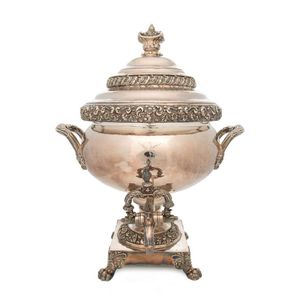Verdigris Bronze 'Ding' Censer with Jade-Embellished Lid
You must be a subscriber, and be logged in to view price and dealer details.
Subscribe Now to view actual auction price for this item
When you subscribe, you have the option of setting the currency in which to display prices to $Au, $US, $NZ or Stg.
- Finial - An architectural decoration, found on the upper parts of of an object. On furniture they are usually found on pediments, canopies and shelf supports. On smaller ceramic or silver items, such as spoons, they may decorate the top of the item itself, or the lid or cover where they provide a useful handle for removal.
Finials have a variety of shapes and forms. They may be urn-shaped, baluster shaped round or spiral, but usually taper into an upper point. Many real life shapes may also be used as finials, such as pineapples, berries, pinecones, buds, lotus and acorns. Sometimes animals such as a lion are depicted, or fish and dolphins. - Ming Dynasty - The Ming Dynasty was a ruling dynasty of China from 1368 to 1644. It succeeded the Yuan Dynasty and preceded the Qing Dynasty. The Ming Dynasty was established by Zhu Yuanzhang, a former Buddhist monk who became a rebel leader and eventually overthrew the Mongol Yuan Dynasty. During the Ming Dynasty, China experienced a period of relative stability and prosperity. The government was centralized and bureaucratic, with the emperor at the top of the hierarchy. The Ming Dynasty is known for its cultural achievements, including the development of porcelain, the invention of movable type printing, and the construction of the Great Wall of China.
- Patination / Patina - In broad terms, patination refers to the exterior surface appearance of the timber, the effect of fading caused by exposure to sunlight and air over the course of a century or more, changing the piece to a soft, mellow colour.
As patina is very difficult to replicate, it is one of the most important guides to determining the age of furniture.
Patina is also the term applied to the bloom or film found on old bronzes due to oxidisation. - Qing Dynasty - The Qing Dynasty was the last imperial dynasty of China, ruling from 1644 to 1912. It was established by the Manchu people, who originated from the northeastern region of China. The Qing Dynasty was preceded by the Ming Dynasty and followed by the Republic of China.
- Bronze - An alloy of copper and tin, traditionally in the proportions of about 9 parts of copper to 1 part of tin.
The discovery of bronze in Western Asia in the 4th century enabled people to create metal objects which were superior to those previoulsy possible because of its strength and hardness, and it has been used throughout the world for weapons, coins, tools, statuary and other decorative items.
It is very fluid in a molten state, and its hardness, strength when set, and non-corrosive properties makes it most suitable for casting sculpture. - Chinese Ding Porcelain - Ding ware is a type of Chinese porcelain that was produced in the northern city of Ding in the Hebei province during the Song Dynasty (960-1279). It is considered to be one of the "Five Great Kilns" of Chinese ceramics, along with Jian, Jun, Guan, and Ru wares.
Ding ware is known for its fine white porcelain body, which was made from kaolin clay, and its elegant shapes and designs. The glaze on Ding ware is usually transparent and has a bluish-white or grayish-white color. It was often decorated with underglaze blue or iron-brown designs.
Ding ware was highly prized during the Song Dynasty, and it was exported throughout Asia and as far as the Middle East and the Mediterranean. It was also an inspiration for other porcelain-making centers in China and Japan. The production of Ding ware declined after the Song Dynasty, and it is now considered to be a rare and valuable collectible.
This item has been included into following indexes:
Visually similar items

A Goldstone archaic style libation cup with stand, height 13.5 cm

A superb George IV silver gilt lidded yachting cup by Benjamin Smith, dated 1827, London engraved 'From Her Royal Highness the Duchess of Kent For Beaumaris Regatta 1832'. Inscribed on reverse, 'Won By the Zephyr Yacht Belonging to James Watson Esq. of Liv

A Victorian silver plated samovar, with central armorial crest, English, 19th century. 46 cm high

A bronze Ding style censer, 19th century decorated with lotus and zoomorphic face pattern, coupled with zoomorphic legs, 18 cm high with stand. Provenance: A private collection in Japan
